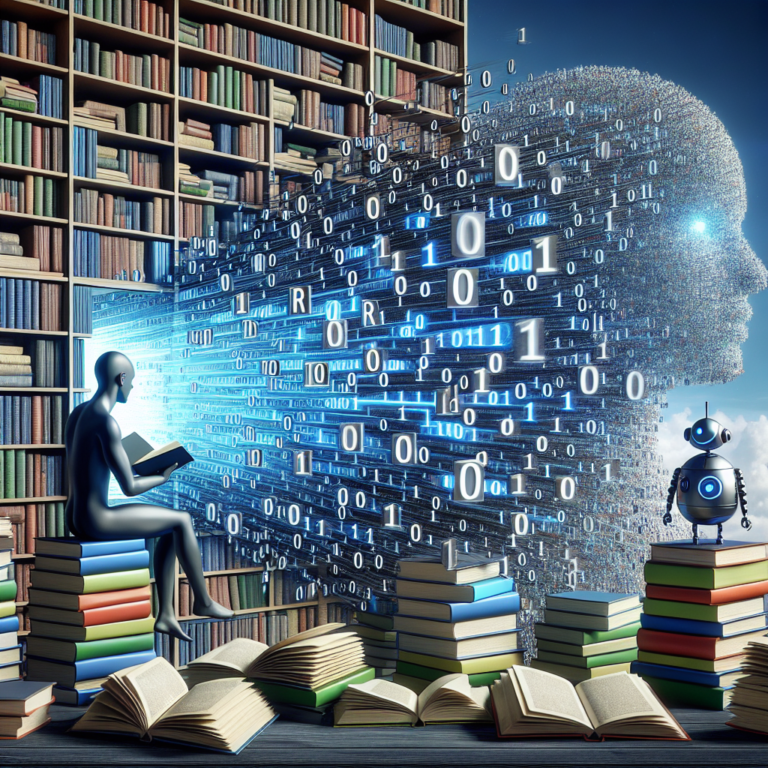
Are you eager to dive into the captivating world of AI but not sure where to start? Look no further! In this article, you will discover a comprehensive guide that will empower you to learn AI. From understanding the fundamental concepts to exploring various resources and tools, this article will equip you with the knowledge and skills needed to embark on your journey of mastering AI. So, let’s get started on this exciting adventure together and unlock the limitless possibilities of artificial intelligence!

1. Understanding the Basics
1.1 What is Artificial Intelligence?
Artificial Intelligence (AI) is a branch of computer science that aims to create intelligent machines that can perform tasks that typically require human intelligence. AI involves the development of algorithms and models that allow computers to simulate human intelligence by learning from data, recognizing patterns, and making decisions based on that information. AI encompasses a wide range of techniques and approaches, including machine learning, deep learning, natural language processing, and computer vision.
1.2 Different Types of AI
There are different types of AI systems, each with its own specific characteristics and capabilities. Some common types of AI include:
- Rule-based AI: This type of AI uses predefined rules and logic to make decisions and solve problems. It operates based on a set of if-then statements and does not require any learning from data.
- Machine Learning (ML): ML is a subset of AI that focuses on the development of algorithms and models that can automatically learn from data without explicit programming. It uses statistical techniques to find patterns and make predictions or decisions.
- Deep Learning: Deep learning is a subfield of machine learning that uses artificial neural networks to simulate the workings of the human brain. It can process large amounts of data and is particularly effective in areas such as image and speech recognition.
- Natural Language Processing (NLP): NLP is a branch of AI that focuses on the interaction between computers and human language. It enables computers to understand, interpret, and generate human language, allowing for applications such as language translation and virtual assistants.
- Computer Vision: Computer vision is a field of AI that enables computers to understand, analyze, and interpret visual data from images and videos. It is used in areas such as face recognition, object detection, and autonomous vehicles.
1.3 Importance of AI in Today’s World
AI is playing an increasingly crucial role in today’s world across various industries and sectors. Here are some key reasons why AI is important:
- Automation: AI enables automation of routine and repetitive tasks, freeing up human resources to focus on more complex and creative tasks. This leads to increased efficiency and productivity.
- Decision Making: AI algorithms can analyze large amounts of data and make predictions or recommendations, aiding decision-making processes in areas such as finance, healthcare, and marketing.
- Personalization: AI technologies, such as recommender systems, can personalize user experiences by understanding individual preferences and making tailored recommendations.
- Improved Efficiency: AI can optimize processes and systems by identifying patterns and inefficiencies, leading to cost savings and improved performance.
- Advancements in Healthcare: AI is revolutionizing healthcare by enabling the development of diagnostic tools, predictive models, and personalized medicine.
- Enhanced Security: AI-based systems can detect and respond to security threats, helping to protect sensitive data and infrastructure.
2. Building the Foundation
2.1 Mathematics and Statistics
To develop a solid foundation in AI, it is essential to have a good understanding of mathematics and statistics. Mathematics forms the basis for many AI algorithms and models, particularly those in the field of machine learning. Key mathematical concepts and techniques include linear algebra, calculus, probability theory, and optimization. Statistics is crucial for analyzing and interpreting data, as well as for understanding concepts such as probability distributions, hypothesis testing, and regression analysis.
2.2 Programming Languages for AI
Proficiency in programming languages is essential for implementing AI algorithms and models. Some commonly used programming languages in AI include Python, R, and Java. Python is particularly popular in the AI community due to its simplicity, readability, and extensive libraries for machine learning and data analysis, such as TensorFlow and scikit-learn. R is another popular choice, especially for statistical analysis and visualization. Java is widely used in AI applications that require scalability and performance.
2.3 Data Structures and Algorithms
Understanding data structures and algorithms is crucial for efficient data processing and problem solving in AI. Being able to choose the right data structure and algorithm can greatly impact the performance and efficiency of AI systems. Some key data structures and algorithms commonly used in AI include arrays, linked lists, trees, graph algorithms, and optimization algorithms.
3. Exploring Machine Learning
3.1 Introduction to Machine Learning
Machine Learning (ML) is a subset of AI that focuses on the development of algorithms and models that can automatically learn from data without explicit programming. ML algorithms are trained on labeled data to recognize patterns and make predictions or decisions. There are different types of ML algorithms, including supervised learning, unsupervised learning, and reinforcement learning.
3.2 Supervised Learning
Supervised learning is a type of ML where the algorithm is trained on a labeled dataset, where the desired output is known. The algorithm learns to generalize from the labeled examples and make predictions on unseen data. Some common examples of supervised learning algorithms include linear regression, logistic regression, decision trees, and support vector machines.
3.3 Unsupervised Learning
Unsupervised learning involves training ML algorithms on unlabeled data, where the desired output is unknown. The algorithms learn to identify patterns and relationships in the data without explicit guidance. Clustering, dimensionality reduction, and anomaly detection are some common techniques used in unsupervised learning.
3.4 Reinforcement Learning
Reinforcement learning is a type of ML where an agent learns to interact with an environment and maximize a reward signal. The agent takes actions and receives feedback in the form of rewards or penalties, which guides its learning process. Reinforcement learning has been successfully applied in areas such as robotics, game playing, and autonomous vehicles.
4. Understanding Deep Learning
4.1 Neural Networks
Neural networks form the foundation of deep learning. They are a set of interconnected nodes, or artificial neurons, arranged in layers. The connections between neurons have weights that are adjusted during training to optimize the network’s performance. Deep neural networks can have multiple hidden layers, enabling them to learn complex representations and hierarchies of data. Convolutional Neural Networks (CNNs) and Recurrent Neural Networks (RNNs) are two popular types of neural networks used in deep learning.
4.2 Training Deep Learning Models
Training deep learning models involves feeding large amounts of labeled data to the neural network and adjusting the weights to minimize the difference between predicted and actual outputs. This is done through a process called backpropagation, where gradients are calculated and used to update the weights. This iterative process continues until the model converges to its optimal performance.
4.3 Convolutional Neural Networks (CNN)
CNNs are a type of neural network specifically designed for image processing tasks. They are highly effective in tasks such as image classification, object detection, and image segmentation. CNNs utilize specialized layers, including convolutional layers, pooling layers, and fully connected layers, to extract meaningful features from images and make predictions.
4.4 Recurrent Neural Networks (RNN)
RNNs are a type of neural network suitable for sequential data, such as text or time series data. Unlike feedforward neural networks, RNNs have feedback connections that allow them to maintain internal memory and process sequences of arbitrary length. This makes RNNs well-suited for tasks such as language modeling, speech recognition, and sentiment analysis.

5. Getting Hands-On with AI
5.1 AI Development Environments
To get hands-on with AI, it is important to have access to suitable development environments. Some popular AI development environments include Jupyter Notebook, Google Colab, and TensorFlow Playground. These environments provide a convenient and interactive way to develop and experiment with AI models, as well as visualize and analyze results.
5.2 Frameworks and Libraries
AI frameworks and libraries offer pre-built tools and functions that simplify the development and deployment of AI models. Some commonly used frameworks and libraries in AI include TensorFlow, PyTorch, scikit-learn, and Keras. These frameworks provide high-level abstractions and APIs that allow developers to focus on model development rather than low-level implementation details.
5.3 Working with Datasets
Working with datasets is a fundamental aspect of AI development. Datasets contain the necessary information for training and evaluating AI models. There are several sources for datasets, including public repositories like Kaggle, academic datasets, and specialized datasets for specific domains. It is important to preprocess and clean the data before feeding it to AI models to ensure accurate results.
5.4 Implementing AI Models
Implementing AI models involves designing and coding the algorithms and architectures required for the desired application. This can include implementing neural networks, designing feature extraction techniques, and optimizing the model’s performance. It is important to understand the underlying principles and guidelines for implementing AI models effectively and efficiently.
6. Exploring AI Applications
6.1 Natural Language Processing (NLP)
NLP is a branch of AI that focuses on enabling computers to understand, interpret, and generate human language. NLP techniques are used in a wide range of applications, including language translation, sentiment analysis, chatbots, and voice assistants. NLP combines several AI techniques, such as text classification, named entity recognition, and language modeling, to process and analyze text data.
6.2 Computer Vision
Computer vision is a field of AI that enables computers to understand, analyze, and interpret visual data from images and videos. It has applications in areas such as image classification, object detection, facial recognition, and autonomous vehicles. Computer vision algorithms utilize techniques such as image preprocessing, feature extraction, and deep learning to extract meaningful information from visual data.
6.3 Robotics
AI plays a crucial role in robotics by enabling machines to perceive their environment, make decisions, and manipulate objects. Robots equipped with AI capabilities can perform tasks that were previously deemed too complex or dangerous for humans. Robotics combines various AI techniques, including computer vision, path planning, and reinforcement learning, to enable autonomous and intelligent robotic systems.
6.4 Recommender Systems
Recommender systems are AI applications that provide personalized recommendations to users based on their preferences and behavior. They are widely used in e-commerce, streaming platforms, and social media. Recommender systems utilize techniques such as collaborative filtering, content-based filtering, and reinforcement learning to analyze user data and make accurate recommendations.
7. Staying Updated with AI
7.1 Following AI Researchers and Experts
To stay updated with the latest advancements and trends in AI, it is important to follow leading AI researchers and experts. This can be done through subscribing to their blogs, following them on social media platforms, and attending their webinars or lectures. Following experts in the field provides valuable insights and access to cutting-edge research and developments.
7.2 Joining AI Communities and Forums
Joining AI communities and forums allows you to connect with like-minded individuals who share your passion for AI. These communities provide opportunities for learning, collaboration, and discussion. Participating in online forums, attending meetups, and joining AI-related groups on social media platforms can help you stay connected to the AI community and exchange ideas.
7.3 Attending AI Conferences and Events
Attending AI conferences and events is an excellent way to stay updated with the latest trends and advancements in AI. These events bring together researchers, practitioners, and industry experts who share their insights and discoveries. AI conferences often include keynotes, technical sessions, workshops, and networking opportunities, providing a comprehensive learning experience.
8. Ethical Considerations in AI
8.1 Privacy and Security
AI technologies often deal with sensitive user data, raising concerns about privacy and security. It is important to ensure that AI systems are designed and implemented with robust security measures to protect user data from unauthorized access or misuse. Implementing data encryption, anonymization techniques, and secure access controls can help address privacy and security concerns in AI.
8.2 Bias and Fairness
AI systems are susceptible to biases that can result in unfair or discriminatory outcomes. Biases can arise due to biased or incomplete training data, biased algorithms, or biased decision-making processes. It is crucial to address these biases and ensure that AI systems are fair and equitable. This can be achieved through careful data collection and preprocessing, algorithmic transparency, and ongoing monitoring and evaluation.
8.3 Transparency and Accountability
Transparency and accountability are important ethical considerations in AI. Users should have a clear understanding of how AI systems make decisions and what data is being used. AI models should be explainable and auditable to ensure transparency. Additionally, there should be mechanisms in place to hold AI developers and users accountable for the actions and decisions made by AI systems.
9. Advancing Your AI Skills
9.1 AI Specializations and Advanced Courses
To advance your AI skills, consider pursuing specialized AI courses or programs. Many universities and online platforms offer AI specializations and advanced courses that cover a wide range of AI topics in-depth. These courses often include hands-on projects and assignments that allow you to apply your knowledge to real-world problems. Continuous learning and gaining expertise in specific subfields of AI can help you stand out in the field.
9.2 Participating in Kaggle Competitions
Kaggle is a popular online platform that hosts machine learning competitions. Participating in Kaggle competitions allows you to apply your AI skills to solve real-world problems and learn from the community. Kaggle provides datasets, evaluation metrics, and a platform for submitting and comparing your solutions with other participants. The competitive nature of Kaggle competitions can be a great way to push yourself and learn from others.
9.3 Contributing to Open Source AI Projects
Contributing to open source AI projects is a valuable way to gain practical experience and collaborate with the AI community. Open source projects often have diverse teams working on various aspects of AI, providing opportunities to learn from others and contribute to cutting-edge research and development. Contributing to open source projects can also help you build a strong portfolio and establish your credibility in the AI community.
10. Career Opportunities in AI
10.1 AI Job Roles and Salaries
AI offers a plethora of exciting job opportunities across various sectors. Some common AI job roles include data scientist, machine learning engineer, AI researcher, AI strategist, and AI consultant. The demand for professionals with AI skills is growing rapidly, and salaries in the field are generally high. However, the level of expertise and specialization can significantly impact job prospects and salary ranges.
10.2 Industries and Sectors with AI Opportunities
AI is being adopted across industries and sectors, creating diverse opportunities for AI professionals. Industries such as healthcare, finance, retail, manufacturing, and transportation are leveraging AI to enhance their operations and achieve better outcomes. AI is also being applied in emerging areas such as autonomous vehicles, smart cities, and sustainability. Identifying industries and sectors that align with your interests can help you target AI opportunities effectively.
10.3 Building a Career Path in AI
Building a successful career in AI requires continuous learning, networking, and practical experience. It is important to identify your interests and strengths within the broad field of AI and focus on developing specialized skills in those areas. Building a strong portfolio of AI projects and staying updated with the latest advancements can help you demonstrate your expertise. Networking with professionals and participating in AI communities can provide valuable connections and job opportunities.
In conclusion, learning AI involves understanding the basics, building a strong foundation in mathematics and programming, exploring machine learning and deep learning techniques, and gaining hands-on experience with AI development environments and frameworks. It is important to stay updated with the latest advancements, consider ethical considerations, and continuously advance your skills and knowledge to thrive in the dynamic field of AI. With the increasing demand for AI professionals and the wide range of applications, building a career in AI can lead to exciting opportunities in various industries and sectors.






